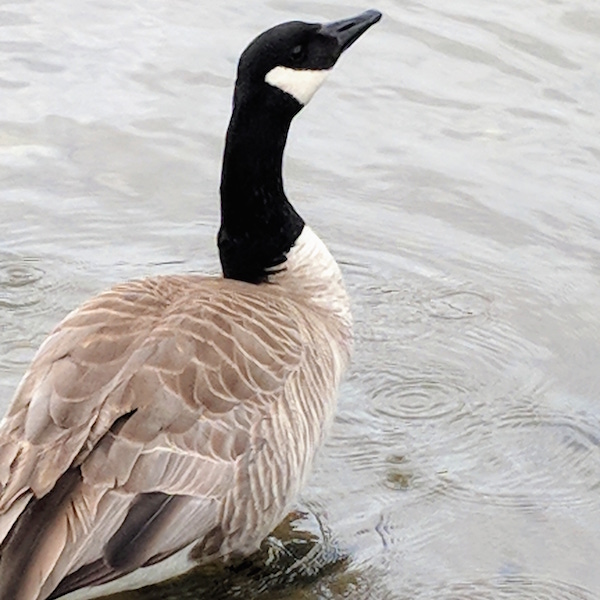
In the fall of 1969, somewhere in Ohio, scientists put a numbered plastic tag around the leg of a one year-old, female Canada goose, and released it into the wild. When it was eventually shot down in Ontario, in 2001, it was 33 years old — the oldest Canada goose to be recorded in the United States Geological Survey’s archive of bird longevity.
I have to admit, when I first learned that Canada geese can live to be more than 30 years old, I thought: that is a very long time to be a goose.
Where I live in Northern California, many Canada geese don’t migrate. Instead, like all the other locals — lots of seasonal boaters, pot farmers and telecommuters — they just hang out on the river, being what the Fish & Wildlife Service now considers “nuisance animals.” They fly upriver, then they fly downriver. They land on one person’s lawn, then on other person’s lawn. Mostly they rip up bermuda grass, honk, poop and hiss.
I thought Canada geese were kind of boring. But that all changed when I called a mustachioed scientist named Paul Curtis, who runs the Wildlife Damage Management Program at Cornell. Canada geese are not boring — they are winning, I learned. Once driven close to extinction, today Canada geese are living the American dream.
Like wood ducks and wild turkeys, Canada geese got wiped out in the late 1800s by hunters and egg collectors. By the 1920s, many thought one species, the Giant Canada goose, was exinct. In the 1950s, however, the U.S. Fish and Wildlife Service found a remnant population of Giant Canada goose in North Dakota, and started a breeding program.
Eventually the Giant Canada goose came back and other Canada goose populations were revived, such as the duck-sized Aleutian Canada goose, which was on the Endangered Species List until 2001.
Today, most Canada geese are thriving, Curtis told me. They are doing so well, in fact, that if you are the sort of person who would destroy a clutch of Canada goose eggs on your property to save your lawn, you can go on the agency’s website and download a free permit.
“I don’t think biologists realized how adaptable Canada geese would be in suburban and urban environments,” says Curtis. Most Canada geese do not live to be 30, but are lucky to reach age 10, he says. Still, each breeding pair produces about six young per year, and in urban and suburban areas where the weather is mild and predators few, survivorship of the young is 50-70 percent.
“If an adult female lives 10 years and she produces, say, 50-60 young over a 10-year period, only one adult female has to survive to replace the population,” he says. “That’s why we see such tremendous exponential growth.”
Curtis thinks resident Canada geese have pretty much saturated available habitat in the eastern United States, where they were first reintroduced. But that’s not true in the West, where resident geese arrived later. All a Canada goose really needs is a lawn near water, and Westerners are happy to provide new retention ponds, and housing developments. In other words, “there’s still lots of opportunity for growth,” he says.
People who don’t like Canada geese often complain about their green poop on soccer fields and beaches. Some worry it will spread disease but “it’s difficult to find a smoking gun, an actual case where someone’s slipped in goose feces and gotten sick afterward,” Curtis says.
More serious concerns include getting killed when geese are sucked into aircraft engines, and contamination of water supplies with microorganisms like giardia.
Border collies, fire crackers, culling adult birds, puncturing and oiling eggs. Every conceivable mode of goose deterrent is being attempted, and yet the geese persist. Each summer, male and female geese drop their stiff flight feathers in order to grow new ones, a process that takes several weeks. They can’t fly at all during this period, so geese without goslings usually attempt to fly to a safe pond before they lose their feathers, to molt in peace. Parents with young that can’t fly yet must stay put or set out on foot, Curtis told me, sometimes walking miles with goslings in tow.
Thinking about those vulnerable, flightless geese has changed how I feel about our residents. Their lives aren’t boring at all, but full of drama. Their decision to settle down in the suburbs isn’t complacency, but good parenting. I like it when the geese take off from the soccer field en masse, beating their wings and filling the air with feathers. I like how they land on the river like water-skiiers, webbed feet outstretched. And now, I’ll enjoy the sound of their honking as they fly upriver in V-formation every morning — so what if they’re only migrating half a mile in search of greener grass.